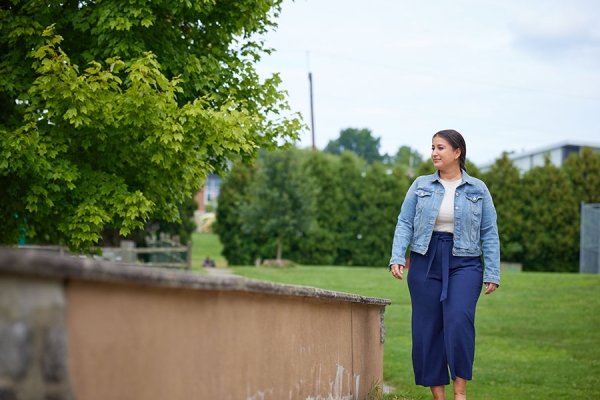Like many busy 20-somethings, Nicole C. experienced hectic times at work. In November 2017, one such time was especially frantic, and Nicole thought her long workdays were affecting her health.
“I was just feeling down and had a little cough,” she recalls. “I work in human resources and it was open enrollment period for benefits, so I thought I’d just been working a ton. I just wasn’t feeling quite like myself and honestly thought that maybe I had bronchitis or just a common cold.”
One night the week after Thanksgiving, Nicole went out to eat. When she arrived home, she started coughing in a way she never had before.
“I walked in the front door and was unpacking my things. All of a sudden, I had this crazy coughing fit,” Nicole recalls. “I just could not catch my breath. I’ve since told my doctors it felt like my lungs turned to stone and just totally locked up. Imagine if you were coughing and trying to catch your breath, but you’re never able to catch it.”
Although her husband wanted Nicole to get immediate medical help, she decided to lie on the couch and take it easy the rest of the evening. But in the morning, she knew she needed to take action.
“When I woke up, I knew something wasn’t right,” she says. “Almost every step I took, I got this nauseating wave that took over me, like my body was going to give out at any second, which I’ve now come to find out could have been the case.”
Getting the blood clot diagnosis
Nicole went to an urgent care center near her home in Willow Grove. The providers there thought her symptoms might be asthma, which Nicole had as a child. But they encouraged her to make an appointment with her primary care physician. The next day, Nicole saw her regular provider.
“My primary care doctor said, ‘It sounds like it could be an icky cough with a common cold, but it also could be a blood clot. So I’m going to send you to Chestnut Hill Hospital, and you’re going to get scanned there,’” Nicole says.
The team at Chestnut Hill Hospital performed scans that identified multiple blood clots in both of Nicole’s lungs — a condition called pulmonary embolism (PE). The clots blocked the normal flow of blood in her lungs and reduced the amount of oxygen in her blood. PE makes the heart work too hard and can cause serious complications or even death.
The doctors at Chestnut Hill Hospital knew Nicole needed care from specialists, and quickly, so they transferred her to Temple University Hospital.
Pulmonary embolism specialists
Temple’s Pulmonary Embolism Response Team knows that time is of the essence when treating these blood clots. That’s why the team was there to meet Nicole after she was transported by ambulance to Temple.
“I was rushed back to the ER, and that’s where I met Dr. Rali and started to interact with the wonderful team that ended up saving my life,” Nicole says.
Temple’s PE team is a multidisciplinary group including clinicians from specialties like pulmonary and critical care, cardiology, and hematology. Parth Rali, MD, leads the team and recommended catheter-directed thrombolysis for Nicole. This procedure uses drugs and ultrasound waves to break up blood clots. Temple is the only hospital in the Philadelphia area equipped to perform this procedure for certain conditions like blood clots in the lungs.
“Ever since the moment I met Dr. Rali, he put me totally at ease,” Nicole says. “He explained exactly what he thought they needed to do, and he asked if we were comfortable with that. We all were, but we talked about it — talked about the risks with the procedure. And then we went for it. From there on out, the care I got at Temple is unmatched.”
After a successful procedure and a few days in the hospital, Nicole went home to recover.
Thriving after PE
Now 32, Nicole is living a full life. But bouncing back from PE and learning about the risks hasn’t been easy.
“Recovery was nothing like I expected,” she says. “Before this happened to me, I didn’t know anything about blood clots. I’d never known someone personally with a blood clot — certainly no one my age. I didn’t really know what to expect.”
When she got home from the hospital, Nicole couldn’t climb stairs.
“I could barely walk back and forth in our house without getting out of breath,” she says. “It was slow and steady.”
